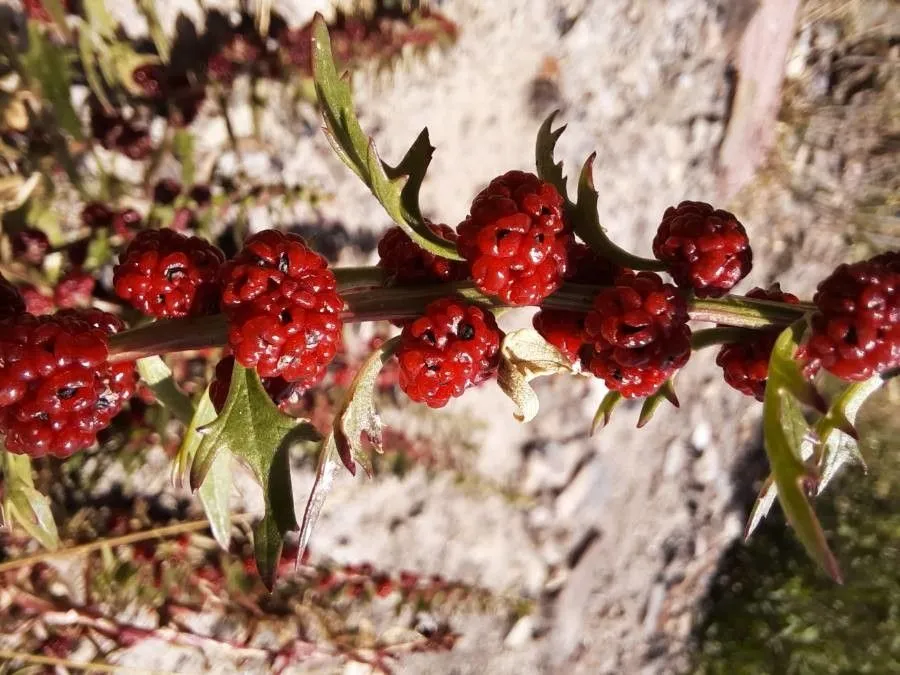
Author: Asch.
Bibliography: Unknown
Year: Unknown
Status: accepted
Rank: species
Genus: Chenopodium
Vegetable: Unknown
Observations: Unknown
Leafy goosefoot, scientifically known as Chenopodium foliosum, is an intriguing plant that belongs to the Amaranthaceae family. This plant is noted for its unique appearance and ecological significance. While not much is widely known or documented regarding its detailed bibliography or specific observations, the distinguishing features of the leafy goosefoot are well worth noting.
Chenopodium foliosum is a hardy species that typically thrives in a variety of soil conditions, often found in disturbed grounds, gardens, and along the edges of agricultural fields. The plant is recognized for its somewhat bushy appearance and the distinctive shape and texture of its leaves, which resemble the webbed foot of a goose—hence its common name.
The leaves of this plant are typically broad, with a characteristic texture that can help in identifying the plant in the wild. They exhibit a lush green color and have a slightly mealy surface, a common trait within the genus Chenopodium. These leaves are not just a visual treat; they also contribute to the plant’s value in traditional and contemporary uses.
In some cultures, leafy goosefoot has been utilized for its nutritional properties. The leaves are edible and can be cooked or eaten raw, offering a source of vitamins and minerals. However, it is always advisable to seek proper guidance before consumption due to potential concerns with saponins and other natural compounds present in the foliage.
Although detailed empirical observations are lacking, Chenopodium foliosum is assumed to share many ecological and practical characteristics with its close relatives within the Amaranthaceae family. This includes its role in providing habitat and food for various insects and animals, contributing to the biodiversity and health of the ecosystems where it grows.
Given the broad family to which it belongs, leafy goosefoot is part of a group known for its versatile and often resilient members, many of which have adaptations that allow them to flourish in less-than-ideal soil environments.
In conclusion, the leafy goosefoot, or Chenopodium foliosum, is a noteworthy member of the Amaranthaceae family, appreciated for its distinctive foliage and potential nutritional value. While specific detailed observation data might be scant, understanding its general characteristics within the broader context of the family can provide insightful information into its role and benefits within its natural habitat.
En: Leafy goosefoot, Strawberry goosefoot
Cs: Merlík listnatý
Nl: Rode aardbeispinazie
Et: Vits-hanemalts
Fi: Marjasavikka
Fr: Épinard-fraise en baguette
De: Durchblätterter Gänsefuß, Echter Erdbeerspinat, Erdbeerspinat
Hu: Vesszősparéj
It: Farinello foglioso
Lv: Lapain
Lt: Gausialapė balanda
Taken Aug 1, 2021 by Miguel A. C. (cc-by-sa)
Taken Aug 1, 2021 by Miguel A. C. (cc-by-sa)
Taken Aug 1, 2021 by Miguel A. C. (cc-by-sa)
Taken Aug 1, 2021 by Miguel A. C. (cc-by-sa)
Family: Myrtaceae Author: (F.Muell.) K.D.Hill & L.A.S.Johnson Bibliography: Telopea 6: 402 (1995) Year: 1995 Status:…
Family: Rubiaceae Author: Pierre ex A.Froehner Bibliography: Notizbl. Bot. Gart. Berlin-Dahlem 1: 237 (1897) Year:…
Family: Sapindaceae Author: Koidz. Bibliography: J. Coll. Sci. Imp. Univ. Tokyo 32(1): 38 (1911) Year:…
Family: Asteraceae Author: A.Gray Bibliography: Pacif. Railr. Rep.: 107 (1857) Year: 1857 Status: accepted Rank:…
Family: Fabaceae Author: Medik. Bibliography: Vorles. Churpfälz. Phys.-Ökon. Ges. 2: 398 (1787) Year: 1787 Status:…
Family: Aspleniaceae Author: (Cav.) Alston Bibliography: Bull. Misc. Inform. Kew 1932: 309 (1932) Year: 1932…